IR-4 Project realized the importance of registering flonicamid for use on safflower to control lygus bugs to prevent damage to other major high value crops.
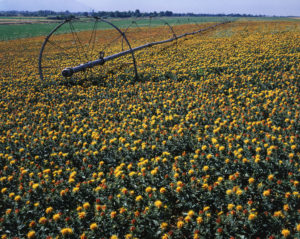
When Beau Howard, a safflower grower and agronomist in California, submitted the project clearance request through IR-4 Project for flonicamid to control lygus bugs (Lygus hersperus) on safflower, he knew safflower was the key to controlling this pest.
“Safflower is the lynch pin of an area wide integrated pest management (IPM) program that encompasses so many facets of farming and pest management,” Howard said. “It has been my goal over the last 10 years to try to get people to understand this. Managing lygus bugs on safflower is part of an overall systems approach of IPM to not only control one pest in one crop, but to control the same pest in other more valuable crops. The cultural practice of growing safflower in rotation with other crops allows for the effective management of soil disease, salinity, air quality and nutrient management. This then allows for a dramatic improvement of soil health and overall sustainability.
“Lygus bugs are not a problem per se on safflower, but safflower is the host crop for the bugs. Lygus bugs proliferate on safflower and then migrate to other more susceptible crops, including Pima cotton and processing tomatoes. Safflower can be used as a trap crop for lygus bugs. If the bugs are controlled on safflower, then they are eliminated from infesting other crops which reduces the number of pesticide applications for those other crops.”
Howard said the difficulty with lygus bugs is that they are highly mobile. They move around quickly and cover long distances relatively rapidly.
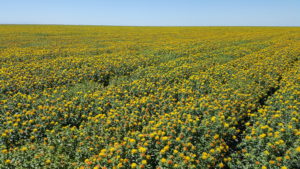
Pima cotton and processing tomatoes. Photo by Shea DeVaney, J.G. Boswell Co
“If there are multiple generations of lygus bugs in a safflower crop and they are allowed to persist and migrate out of that crop, it is very difficult to manage the pest in the overall system,” he said. “Where cotton and tomatoes are intermixed among safflower fields, there is a major concern about the migration issue. That is why growers are working to obtain additional insecticide registrations and that is why flonicamid is important to farmers for control of lygus bugs.”
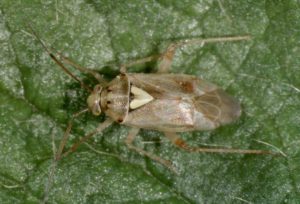
The benefits of safflower
Ken Samoil, research coordinator and study director at IR-4 Project, said the study conducted to obtain the registration for flonicamid on safflower was unusual from studies done by IR-4 on other crops.
“IR-4 usually does residue studies for pesticide use on high value, low acreage crops,” Samoil said. “These would be crops that are of high value to growers, but not to the pesticide manufacturers because of their low acreage. That is why IR-4 gets involved.
“Safflower is not a particularly high value crop, but it is low acreage. It is grown in areas where there are other high value crops. Lygus bugs are a pest on safflower as well as the other crops grown in the area. If a population is allowed to develop in one field, the bugs eventually move to other nearby fields. Even though the damage that lygus bugs cause to safflower may not cost the growers a lot of money, the bugs can cause big losses to other high value crops.”
Safflower is grown as an oil seed crop, but it is worth more in regards to its soil health benefits. “Safflower has a long taproot that opens up channels for salts that are in the soil to leach down below the root zone,” Samoil said. “This allows farmers to plant more profitable crops after the safflower has been harvested.”
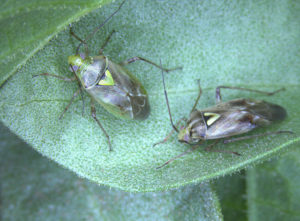
distances relatively rapidly. Photo by Colin Brent, USDA-ARS
Another benefit of safflower is it doesn’t have to be irrigated.
“If there is too much water in the soil, safflower will aggressively mine most of the residual moisture and nutrients left in the soil profile,” Howard said. “This gives farmers the ability to better manage inputs and tillage over a three- to five-year crop rotation when safflower is grown. It also increases the organic matter in the soil and makes the soil more fertile.”
Samoil said farmers are using safflower largely to improve field soils for other high value crops that can be grown after the safflower is harvested.
“Farmers can make money on the safflower, but its biggest use is to improve the soil for other high value crops,” Samoil said. “Some years ago farmers in California’s San Joaquin Valley stopped producing safflower. They tried to only grow high value crops. The soil health got so bad because of salts buildup and soil compaction that the farmers decided it was worth having a safflower crop in their rotation. They actually made more money because they achieved better yields from their other crops by rotating them with safflower.”
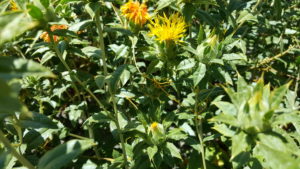
Need to register additional pesticides
Howard said that having a safflower rotation is critical to everything farmers do in the San Joaquin Valley.
“The better farmers can manage lygus bugs on safflower, the better they can manage their overall cropping system,” Howard said. “Having the ability to grow safflower and effectively manage lygus bugs yields a variety of other benefits for growers that are invaluable. This host crop and pest dynamic is intimately connected to many of the sustainability challenges growers will face in the future. Looking at safflower as a key component in a systems approach that encompasses pest management, soil health, nutrient management, water use efficiency and air quality, it becomes clear just how important new chemical registrations are for growers.”
Howard said it was critical for safflower farmers to become engaged with IR-4 Project. “A lot of government agencies don’t recognize the IPM approach,” he said. “We were denied a Section 18 and Section 24c registration for flonicamid because IPM is not a justification for registrations. Fortunately Brian Leahy, former director of California Department of Pesticide Regulation, in 2013 encouraged us to pursue IR-4 as an avenue where we might have some success. IR-4 has been very receptive to us and they understand our strategy and the importance of our approach.
“But it takes time. The six-year registration timeline is not convenient. Even though we have flonicamid registered now, we are still desperately behind in getting other pesticides registered for use on safflower. To date it has been the only thing out there for us to accomplish any type of lygus bug control. We have been very thankful to be a part of IR-4 because it is the only program that has ever yielded any benefits for us in this whole registration effort.”
For more: Beau Howard, California Safflower Growers Association, bhoward@jgboswell.com;
Ken Samoil, IR-4 Project, Rutgers University, samoil@njaes.rutgers.edu.
PR# 11274 Safflower (Lygus bugs)
David Kuack is a freelance technical writer in Fort Worth, Texas; dkuack@gmail.com.
